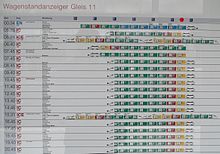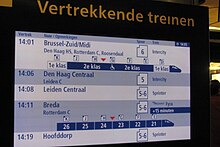Car position indicator

A car position indicator (or car sequence plan) is a schematic representation of all trains on a track in tabular form. He names the order of the cars ; this is used for better orientation on the platform and helps rail travelers to find a specific railway car .
General
The platforms of larger stations (with long-distance passenger traffic ) are divided into sections (A, B, C etc., in some places up to I) - called "sectors" in Switzerland and Austria. The distance between two section marks is the length of two cars . For example, a train with 10 cars occupies sections from A to F. In this way, it is easier for the passenger to find a specific car of a train or to wait in the correct platform area before the train arrives.
This is advantageous, for example, with:
- Use of a course car
- Seat reservation
- For passengers without a seat reservation to find the carriages at the ends of the train, which are often less full
- Search the car class
- Finding the luggage trolley (for bulky luggage or bicycles)
Trains for local rail passenger transport can also be listed in a reduced form ;
History and technology
Originally, car position indicators were made in the form of paper cards that were inserted into a board with parallel bars in the desired order. At today's train stations, you can find them printed out in showcases next to the timetables on a platform or integrated into the train destination displays . Screen displays are also becoming more common. The electronic versions often only show the current train and offer the advantage that different days of operation of individual wagons are already taken into account. Depending on the variant of the indicator (case sheet, digital, etc.), the wagon position indicator can look different and contain different information.
In 2014, 20 percent of DB Fernverkehr trains were incorrectly lined up. Reasons include vehicles used at short notice for defective trains and unscheduled stops at terminal stations . Up to 70 km of turning trips are required to restore the scheduled train sequence . A share of 20 percent was also mentioned in spring 2016.
According to DB information from 2019, the train sequence on the platform is now correctly displayed in 99 percent of cases.
Structure (pressure variant)
"Time" column
The departure times of the trains are shown in the first column of a Deutsche Bahn wagon indicator . The lines are sorted according to these departure times.
"Train" column
The second column shows the type of train and train number as well as brief information and, if applicable, the train name. Here are red all ICE , IC and - EC - and Thalys connections highlighted blue are IR - (ex.) And IRE compounds, and UrlaubsExpress - and night trains (such as DB NachtZug , CityNightLine or Euro Night listings). Other trains, such as trains operated by private railway companies , are listed in black for all connections (without train route, only with train destination and without train number), provided that seat reservations are possible on the trains.
"Direction" column
The third column shows the route of the train, i.e. the destination with a few stops.
Other information
The following is a schematic representation of the trains. The wagons are shown as colored boxes with explanatory pictograms and arranged according to their stopping positions in the sections of the platform. Listed are wagon classes, wagon numbers, the type or equipment features of the wagons and their days of operation and, if applicable, different destinations.
The first class cars are yellow, the second class cars are green, sleeping and couchette cars (the latter also green if necessary) and the dining cars are marked red. Car transport and special vehicles are highlighted in gray. The colors are not chosen arbitrarily. The color blue is due to the paintwork of the CIWL vehicles , red to that of the Mitropa , yellow and green to the former leading colors of the first and second class according to the old three-class system used before 1954.
Long-distance trains usually stop on adjacent tracks so that first-class and second-class cars face each other. For example, on north-south routes in Germany, the first class is at the south end. The exception to this is Mannheim due to its location between the terminal stations in Frankfurt and Stuttgart, in which the direction of travel is changed.
Double-deck cars with both first and second class are not displayed horizontally (above and below), but vertically (left and right). This does not correspond to reality for all double-decker cars, as different classes in double-decker cars are often separated by floor.
The direction of travel, which does not have to be the same for every train on a track, can reverse after a stop or change due to a wing , is also displayed. Using symbols also are power car , driving trailers and locomotive recognized.
See also
Web links
- Marcus Grahnert's private website with unofficial train compositions for Deutsche Bahn trains
- http://www.reisezuege.ch/ Passenger trains in Switzerland and their composition in Switzerland
- Unofficial train compositions in many countries
Individual evidence
- ↑ composition, but correct . In: DB World . No. 5 , 2015, p. 7 .
- ↑ Thiemo Heeg: Every fifth ICE travels backwards through the area . In: Frankfurter Allgemeine Zeitung . No. 91 , April 19, 2016, ISSN 0174-4909 , p. 22 (including title online ).
- ↑ Stefan Schirmer, Claas Tatje: "We fight for every minute every day" . In: The time . No. 44 , October 24, 2019, ISSN 0044-2070 , p. 23 ( online ).



